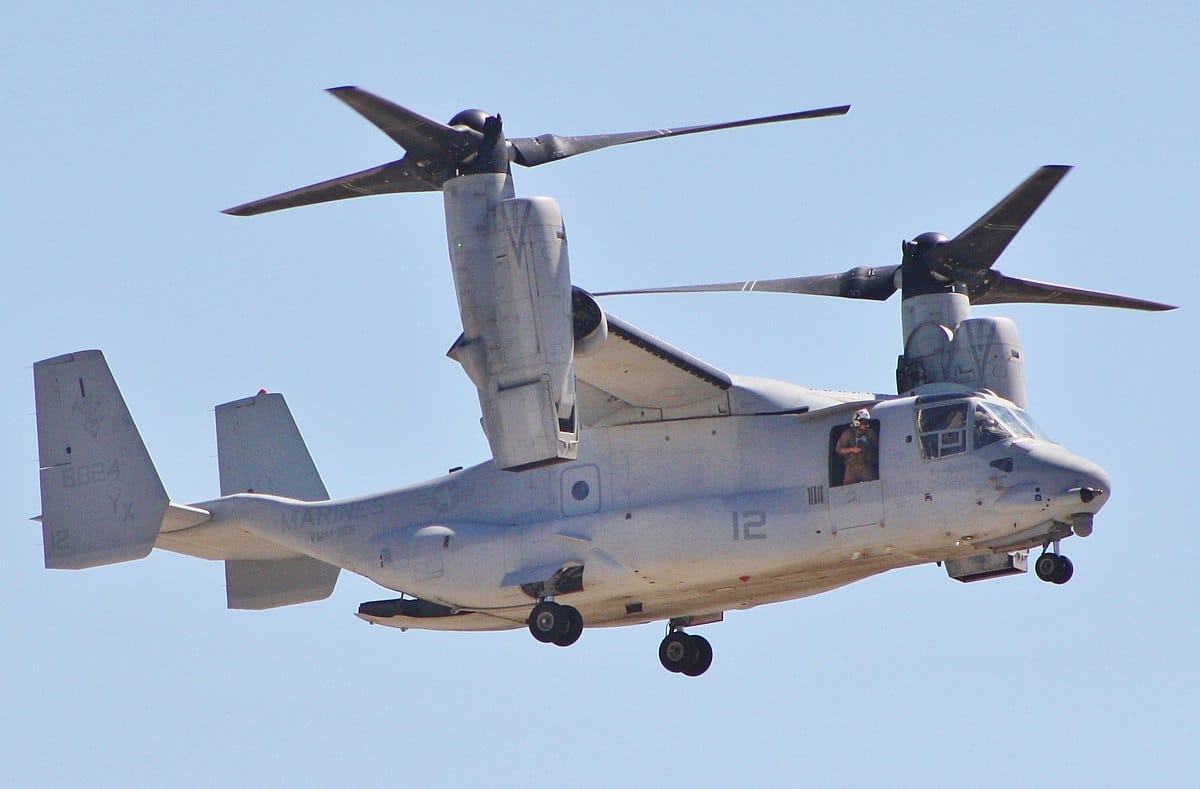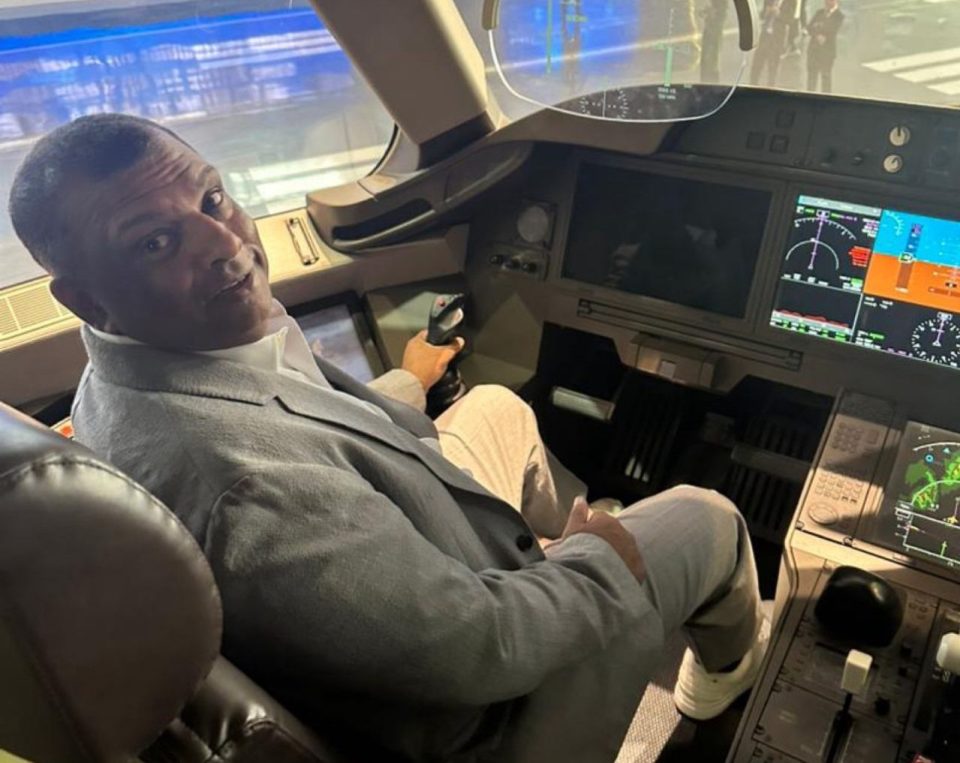Aerospace
The US Air Force no longer grounds its MV22 Osprey
The MV 22 osprey fleet was grounded when one of its aircraft crashed two weeks ago in the desert of southern California

The V22 Osprey aircraft is being reactive by the US air force. The MV 22 osprey fleet was grounded when one of its aircraft crashed two weeks ago in the desert of southern California, sparking concerns about the crew’s and the plane’s safety.
What caused the crash, exactly?
Technically challenging, this aircraft has a crucial component for changing vertical rotors to horizontal ones. The skill of the pilots is also essential to flying this aircraft. Clutch trouble is the main factor in this accident. This issue has been known since 2010, but instead of being corrected, pilots have received training on safe flying practices and emergency management.
10 things which are really special for the US president in AIR FORCE ONE(Opens in a new browser tab)
Although this aircraft presents flying obstacles, the US Marine and Air Force benefit more from its employment. Both a helicopter and an airplane can be operated by this one. Almost 400 aircraft have been produced since 1988. Around 27,442 kg is the maximum takeoff weight for it. More than 9,000 kg of cargo space is accessible, and the aircraft can cruise at a speed of 509 km/h.
After two clutch failures in the previous six weeks, Air Force Special Operations Command grounded its fleet of 52 CV-22 Ospreys on Tuesday. There were two other events after that in 2017.
What steps will the US Air Force take to address the Osprey aircraft issue next?
This issue arises when the clutch that joins the rotor gearbox and engine of the propeller slides. In order to prevent the aircraft from crashing, the Osprey transfers the power load to the other engine nearly immediately.
The osprey lurches as a result of the engine’s power load transferring over a millisecond time span and a considerable amount of torque. Additionally, fixing the gearbox would cost them nearly 2.5 million dollars, so that is not an inexpensive fix. In order to avoid an accident, an aircraft lands in this situation out of safety concerns.
How does a Black Box Work ? its importance in an Aircraft.(Opens in a new browser tab)
How did US marines handle this plane after 533,000 hours of flight?
The Marine Corps is knowledgeable about these aircraft. They have a fleet of 296 Ospreys and have flown 533,000 hours with them. Most marine pilots are currently receiving training to handle such alerts, and they also teach other pilots who are currently flying how to manage them.
In addition, there should be an alert to handle such a scenario carefully. Those instruments will frequently alert the aircrew that such a problem is about to occur so the pilots can quickly and safely land them. More than two-thirds of these problems have occurred seconds after takeoff when power is quickly applied.
Russia prohibits its pilots from working for foreign airlines.(Opens in a new browser tab)
How many Osprey V-22 plane crashes have there been so far?
51 people have died as a result of 13 hull-loss accidents involving the V-22 Osprey. Between 1991 and 2000, there were four crashes during testing that killed 30 people. The V-22 has seen eight crashes, 16 fatalities, and other smaller issues since it began operations in 2007. The aircraft’s history of accidents has caused significant debate over potential safety concerns.

Aerospace
India is set to build a central command for the Air Traffic Control system, called ISHAN

India’s air traffic growth has led to increased responsibilities for air traffic control. The Airports Authority of India (AAI) is considering centralizing air traffic control for aircraft, dividing the country into four regions. The goal is to consolidate India’s segmented airspace into a single entity to improve air traffic management (ATM) efficiency, safety, and smoothness.
Recently, the AAI invited expressions of interest to develop a detailed project report for the Indian Single Sky Harmonized Air Traffic Management (ISHAN) initiative in Nagpur. Under this plan, air traffic controllers in Nagpur would handle domestic flights flying above 25,000 feet, eliminating the need for coordination among controllers in different regions.
For domestic regional flights operating above 25,000 feet, control would shift to the central command in Nagpur. This consolidation aims to enhance airline operations, increase flight handling capacity, and reduce congestion and flight times for passengers.
Currently, the AAI provides ATM services over Indian airspace and adjoining oceanic areas, covering over 2.8 million square nautical miles. This airspace is divided into four flight information regions (FIRs) in Delhi, Mumbai, Kolkata, and Chennai, along with a sub-FIR in Guwahati.
FIRs are responsible for providing air traffic services, including weather information, visibility, and search and rescue assistance. The proposed unification under the ISHAN initiative aligns with the projected growth of the aviation industry, which anticipates a doubling of domestic passenger traffic by 2030.
Aerospace
Does AirAsia show interest in Comac aircraft in the future?

Tony Fernandes, CEO of Capital A, operating as AirAsia Group, recently paid a visit to the facilities of COMAC on April 2, 2024, and was thoroughly impressed by what he witnessed.
C919 already securing nearly 1000 orders
COMAC, known for its homegrown aircraft, has launched two promising jets: the ARJ21 and the C919 aircraft. Both aircraft are gaining popularity in the Chinese market, with the C919 already securing nearly 1000 orders from various airlines.
Fernandes expressed his admiration for COMAC’s achievements in aircraft manufacturing, acknowledging the immense challenge it entails. His visit underscored the realization that AirAsia now has a viable third option when it comes to selecting aircraft for its fleet.
During his tour, Fernandes was delighted by the innovation and technology evident in COMAC’s aircraft production and the company’s commitment to long-term partnerships.
He noted that many Western companies have shifted away from prioritizing loyalty and customer service, opting instead for short-term gains and a narrow definition of success.
Last month, COMAC embarked on an international tour, showcasing demonstration flights to neighboring countries, particularly Indonesia and Malaysia. Fernandes believes that the positive impression left by COMAC during his visit opens up new opportunities for collaboration.
Fernandes emphasized COMAC’s remarkable achievements
The shared values of loyalty, customer service, and long-term vision align closely with AirAsia’s ethos, making collaboration with COMAC appealing. With a focus on innovation and excellence, both companies stand to benefit from a partnership grounded in trust and a shared commitment to success.
Indonesia and China have already collaborated in validating and maintaining the airworthiness of the ARJ21 aircraft, indicating a solid foundation for future partnerships.
In his statement, Fernandes emphasized COMAC’s remarkable achievements and genuine desire for long-term partnership, highlighting the absence of ego and a genuine willingness to succeed together. He marveled at COMAC’s fully automated, AI-driven factory, a testament to their dedication to innovation and efficiency.
Fernandes criticized Western firms for prioritizing short-term gains over loyalty, customer service, and long-term strategy, emphasizing the importance of understanding customers’ needs and collaborating to achieve success.
Aerospace
Indigo will soon launch Air Taxi Service in India

InterGlobe Enterprises, the parent brand of IndiGo, is set to revolutionize travel in India with its upcoming air taxi service.
Scheduled for a potential launch in 2026, this innovative venture promises a seamless journey for passengers between two bustling hubs. Delhi and Gurgaon in Haryana. The forthcoming service is projected to revolutionize the daily commute, offering passengers a swift aerial journey covering the distance in a mere 7 minutes.
This remarkable efficiency contrasts starkly with the conventional 90-minute drive, underscoring the immense time-saving potential for commuters. The anticipated fare, ranging from Rs 2,000-3,000, makes this innovative mode of transport not only swift but also remarkably competitive in pricing.
At the heart of this ambitious endeavor lies a strategic partnership with Archer Aviation, a pioneer in electric vertical takeoff and landing (eVTOL) aircraft technology. Under this collaboration, Archer will supply 200 state-of-the-art eVTOL aircraft, representing an investment of US$ 1 billion. These cutting-edge aircraft, capable of accommodating up to four passengers alongside the pilot, epitomize the future of sustainable air travel.
Powered by six battery packs, Archer’s eVTOL aircraft boast rapid charging capabilities, enabling a swift turnaround between flights. With a charging time of just 30-40 minutes, these eco-friendly aircraft ensure minimal downtime, maximizing operational efficiency.
Similar services are anticipated to be introduced by the joint venture in Bengaluru and Mumbai as well. Nevertheless, the service rollout period has not yet been made public by the company. Next year, it is anticipated to get its certification. Following this, the company will start the certification procedure with the Directorate General of Civil Aviation (DGCA).























